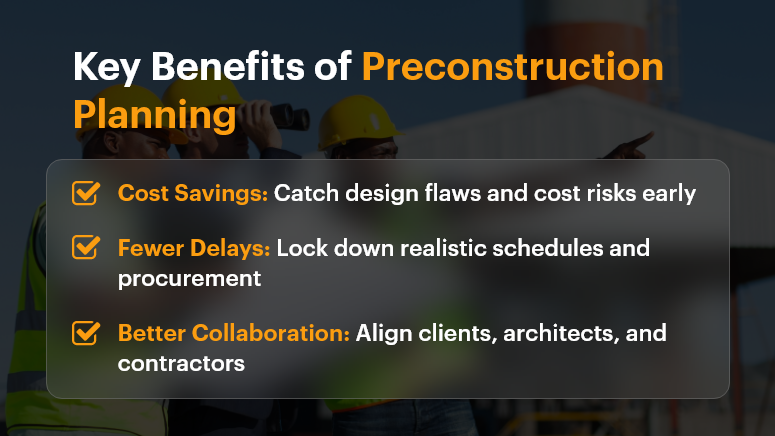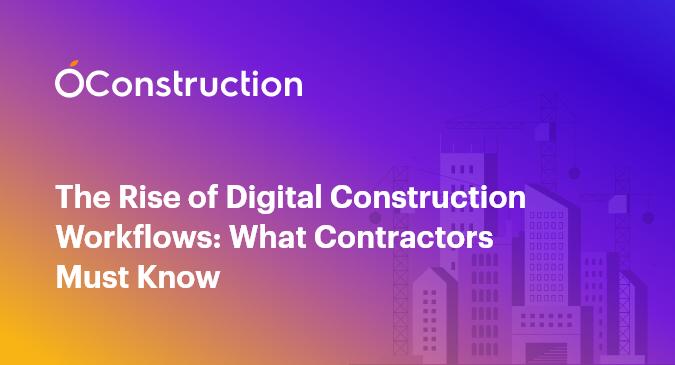Studies reveal that over 60% of construction delays stem from issues that could have been prevented during the planning stage. From misaligned budgets to unclear scopes, these problems don’t appear out of thin air—they originate from skipping or rushing preconstruction planning.
Preconstruction planning is the strategic foundation of every successful project. It aligns budgets, resources, timelines, and expectations before the first brick is laid. Without it, even the best crews and materials can’t save a project from overruns and delays.
In this guide, we’ll explore why preconstruction planning is critical, how it impacts project success, and the exact steps to make it work — using tools like OConstruction to streamline every stage.
Why Preconstruction Planning Matters for Project Success
A construction project isn’t just a collection of tasks—it’s a complex sequence of interconnected decisions. Preconstruction planning ensures those decisions are well-informed and strategically aligned before execution begins.
The Business Case
- Cost Savings – Early planning identifies design flaws and cost risks before they escalate.
- Fewer Delays – By locking down schedules, dependencies, and procurement plans, projects stay on track.
- Better Stakeholder Alignment – Clients, architects, engineers, and contractors work from a shared roadmap.
Who Benefits the Most?
- General Contractors – Gain clarity on scope, resources, and schedules.
- Developers & Investors – Get accurate cost and ROI projections.
- Project Managers – Reduce firefighting by addressing issues upfront.
Pain vs. Solution Contrast
Without preconstruction planning, projects often face:
- Unplanned change orders that blow up budgets.
- Conflicts between design intent and site realities.
- Delays due to unclear task ownership.
With proper planning—especially on OConstruction’s integrated platform—you get:
- Accurate cost estimation tools.
- Centralized document and design coordination.
- Real-time risk tracking before execution begins.
Best Practices & Actionable Strategies for Effective Preconstruction Planning
1. Define Clear Project Objectives
Set measurable goals for budget, scope, and timeline. Every decision during the project should be evaluated against these objectives.
2. Conduct a Feasibility Study
- Assess site conditions, regulatory requirements, and market constraints.
- Use OConstruction to centralize feasibility reports for quick stakeholder access.
3. Build a Realistic Budget and Schedule
- Avoid guesswork by using historical data from similar projects.
- Include contingencies for unexpected delays or costs.
- OConstruction’s construction cost estimation module ensures every line item is accounted for.
4. Assemble the Right Team Early
- Bring in key players—architects, engineers, subcontractors—before construction begins.
- Assign clear responsibilities to avoid role confusion later.
5. Coordinate Design and Preconstruction Documents
- Ensure design drawings match the buildable scope.
- Store and share versions through OConstruction’s document management to prevent errors.
6. Identify and Mitigate Risks
- Conduct a thorough risk assessment covering safety, supply chain, and environmental factors.
- Track and monitor risks in OConstruction’s risk management dashboard.
7. Lock Down Procurement Plans
- Pre-order long-lead items to avoid future bottlenecks.
- Track procurement milestones alongside your schedule in OConstruction.
8. Keep Communication Transparent
- Schedule weekly planning meetings with all stakeholders.
- Use OConstruction’s collaboration tools for updates, RFIs, and design clarifications.
Customer Success Story
For example, a commercial construction firm faced frequent budget overruns due to incomplete early-stage planning. After implementing OConstruction’s preconstruction planning features, they:
- Reduced cost estimation errors by 22%.
- Cut preconstruction review time from three weeks to one.
- Improved on-time project delivery rate by 18%.
They achieved this by centralizing all preconstruction documents, coordinating design reviews within the platform, and tracking procurement against a realistic schedule. The result? Greater client satisfaction and higher profit margins.
Key Takeaways
Preconstruction planning is not an optional step—it’s the blueprint for delivering projects on time and within budget. When you plan effectively, you reduce risks, control costs, and build trust with clients.
Actionable Insights:
- Start early – The sooner you plan, the fewer surprises later.
- Centralize data – Use a platform like OConstruction to keep everyone aligned.
- Plan for change – Include contingency time and budget buffers.
By mastering preconstruction planning, you set your projects up for success before construction even begins.






